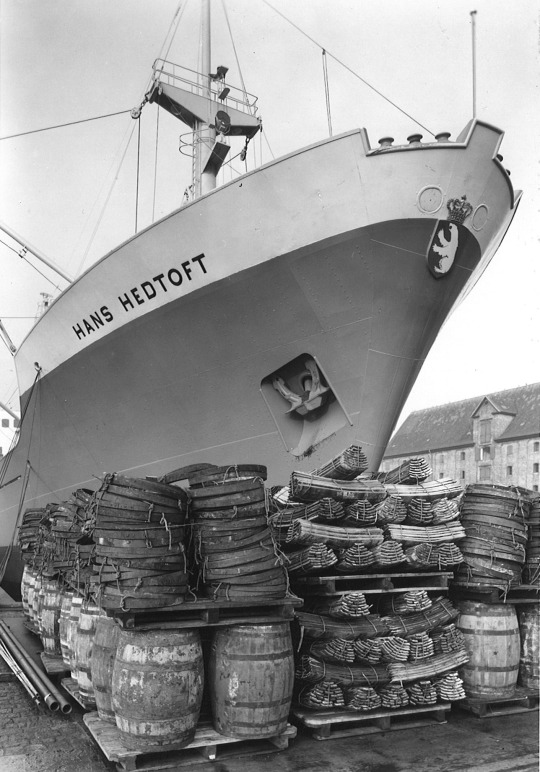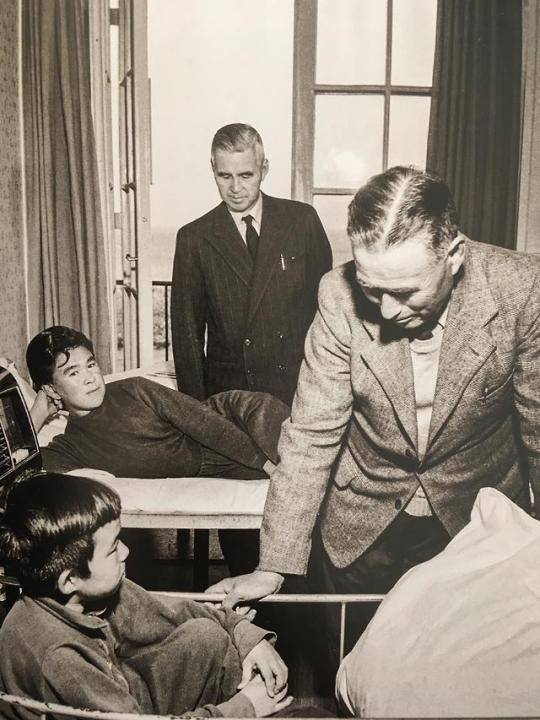#Augo Lynge
Text


vote YES if you have finished the entire book.
vote NO if you have not finished the entire book.
I couldn’t find the cover of the original Greenlandic version, and there’s no English translation, so I’ve included the only two translations I’m aware of, one into Danish and one into French.
(faq · submit a book)
#scifi#books#Ukiut 300-nngornerat#Augo Lynge#poll#j'ai déjà une copie de la traduction française mais (quand je mets ce billet dans le fil d'attente) je l'ai toujours pas lue#mais j'en ai tellement hâte! ce sondage va me motiver#result: no#l: Greenlandic
4 notes
·
View notes
Photo

MS Hans Hedtoft was a Danish liner that struck an iceberg and sank on 30 January 1959 on her maiden voyage off the coast of Western Greenland. The only piece of the wreckage ever found was a lifebelt. As of 2021, she remains the last known ship sunk by an iceberg with casualties.
Hans Hedtoft sailed from Copenhagen on her maiden voyage on 7 January 1959. Her voyage to Julianehaab, Greenland, was made in record time. Hans Hedtoft called at Nuuk, Sisimiut and Maniitsoq before returning to Julianehaab.
On 29 January, she began her return journey. The ship had 40 crew, 55 passengers and a cargo of frozen fish on board and in addition to that 3,25 tons of archives concerning Greenlandic history. One of her passengers was the Danish parliament (Folketing) member Augo Lynge. The next day, Hans Hedtoft collided with an iceberg about 35 miles (56 km) south of Cape Farewell, the southernmost point of Greenland. A distress call was given at 13:56 (local time) stating that the ship had hit an iceberg at 59°30′N 43°00′W. The call was answered by the USCGC Campbell, the West German trawler Johannes Krüss of Bremerhaven and another West German trawler. Within an hour, another message was sent stating that the engine room was flooded. At 15:12, it was announced that the ship was sinking. A final message was sent at 17:41 stating the ship was slowly sinking and requesting immediate assistance. Aircraft in Newfoundland were grounded by the weather and unable to assist in the search for Hans Hedtoft. The beginning of an SOS was received by Johannes Krüss at 17:41 after which communication with Hans Hedtoft was lost. On 31 January, USCGC Campbell reported that conditions were the worst seen and there was no sign of Hans Hedtoft or her passengers and crew. The search was called off on 7 February. The only piece of wreckage ever recovered was a lifebuoy which washed ashore on Iceland and discovered on 7 October 1959, some nine months after the ship sank. The ship sank with parish registers from parishes of Greenland, which were meant to be deposited in archives in Denmark, causing a major loss for Greenlandic genealogy.
As a result of the sinking, the airfield at Narsarsuaq, Greenland, which had closed in November 1958, was reopened. An appeal fund for the relatives of the victims was opened. Kr40,000 (then £2,000) was raised amongst ten countries in two months. Compensation for the relatives amounted to Kr1,184,936 (then £59,000). Like the RMS Titanic, Hans Hedtoft was said to be the safest ship afloat, being described as "unsinkable" by some.
On 30 January 2005, Queen Margrethe unveiled a monument at North Atlantic Wharf, Copenhagen, to the 95 people lost on Hans Hedtoft.
The shipwreck is the theme of the 2014 song "All Hope Abandon" by the Greenlandic band Small Time Giants.
Daily inspiration. Discover more photos at http://justforbooks.tumblr.com
10 notes
·
View notes
Photo

First Greenlandic members of the Danish parliament Augo Lynge and Frederik Lynge visiting a Danish polio hospital. 1953-1959. [3024x4032] Check this blog!
2 notes
·
View notes
Photo

First Greenlandic members of the Danish parliament Augo Lynge and Frederik Lynge visiting a Danish polio hospital. 1953-1959. [3024x4032] #HistoryPorn https://ift.tt/2LTbKUv
0 notes
Text
0 notes
Note
Would you consider pulling the summary/blurbs of these books for inclusion in the polls? I’d love to discover new books through this blog! And it seems from some of your commentary on submitted books that you’re already doing a small bit of research and pulling covers, so it maybe wouldn’t be (much?) more work on your part?
hello! I appreciate the suggestion, but for multiple reasons I’m going to stick with the format as it is.
first, as I discussed on the fantasy poll blog, including blurbs feels like doing promotion for books (even more so than the polls already are to some extent doing), rather than simply asking a factual question about them, and there are certain books and/or authors I categorically do not want to do that for, like Orson Scott Card (Ender’s Game and Ender’s Shadow are both currently queued) and other tithing Mormons.
it also becomes complicated when dealing with non-English books, which are often more difficult to find reliable information — like blurbs — for. I’m thinking for example about older books and books in smaller languages, like Augo Lynge’s Ukiut 300-nngornerat, for which I can’t even find a Danish blurb at the moment, let alone a Greenlandic one, just French and English (ironically, given there’s no English translation). meanwhile some submitted books (like Dave Duggan’s Makaronik, which I just queued this morning) aren’t available in English; would I give just the Irish blurb for it? it creates logistical complications I don’t want to deal with, since queuing things is already a somewhat time-intensive process. (it would be a bit easier if I weren’t committed to my spreadsheets, lol, but still not fast.)
(edit: I actually can find a blurb for the Danish translation of Ukiut 300-nngornerat, but compare the Danish —
I år 2021 fejrer den grønlandske hovedstad 300-året for Hans Egedes ankomst, men uvejr og bankrøveri truer med at spolere festlighederne og ødelægge tilværelsen for flere familier.
— with the French:
En lisant ce roman, le deuxième de la littérature groenlandaise, le lecteur découvrira la vision de l’avenir de l’Arctique en 2021 telle qu’imaginée en 1931 par Augo Lynge, auteur né à Qeqertarsuatsiaat. Selon Per Kunuk Lynge, qui en signe l’avant-propos, « à la lecture de ses anticipations, dont certaines se sont réalisées longtemps après la publication de son roman, on ne peut s’empêcher de voir en l’auteur le chaman inuit d’autrefois, qui voyageait librement autour du monde et était capable de prédire l’avenir ». La vision que nous offre Augo Lynge dans cette intrigue policière entre les villages et l’immense inlandsis glacé est celle d’un pays technologiquement avancé et socialement serein, où les personnages inuits sont devenus ce que sont les Groenlandais d’aujourd’hui : une preuve vivante d’un peuple qui a la capacité de « s’adapter à l’un des climats les plus froids et les plus rudes de la planète » tout en conservant sa langue et sa culture.
leaving aside the no-Greenlandic-blurb issue, this kind of blurb-disproportion was something I observed even just in the first few hours of queuing stuff for the fantasy blog.)
finally, the #1 goal of the polls is for the posts to be as straightforward as possible. the more information I add, the more distracting it gets and (at least speaking from my own experience with polls on my dashboard) the easier it becomes to just scroll by the poll.
5 notes
·
View notes
Photo

First Greenlandic members of the Danish parliament Augo Lynge and Frederik Lynge visiting a Danish polio hospital. 1953-1959. [3024x4032] via /r/HistoryPorn https://ift.tt/2LTbKUv
0 notes